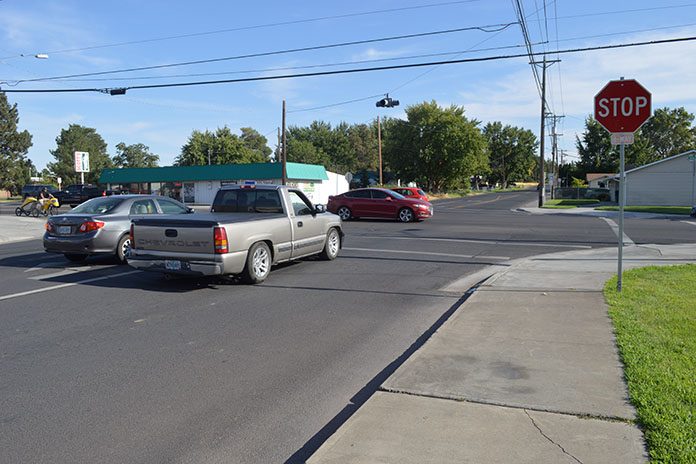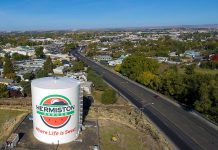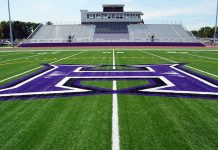
The Hermiston City Council will consider raising Franchise Fees charged to utility companies in order to help pay for improvements to the community’s street network at their next regular meeting Aug. 28.
Councilors listened Monday to the proposal from the Public Infrastructure Committee which will dedicate new annual funding to tackle some of the community’s largest transportation needs.
The city’s Public Infrastructure Committee recommended further investigation in to increasing Franchise Fees at their June 1st meeting in response to the 2017 City Council Goal to develop a comprehensive Capital Improvement Plan. The proposed project list includes high community priorities such as addressing congestion and other issues at the intersections of First & Highland and First & Orchard near Hermiston High School, as well as re-aligning the three-way intersection of Geer, Harper, and First; which also straddles a Railroad crossing. Other projects also include paving East Theater Lane between Eighth & 10th, and paving West Gettman Road between Ninth and First, as well as widening N.E. 10th Street to accommodate students walking to Sandstone Middle School.
“Under our current street funding model, it will take almost 60 years to pay for just our highest priority projects,” said Hermiston Assistant City Manager Mark Morgan. “I don’t think the kids dodging traffic on 10th really want to wait 60 years for a wider street.”
Grant Opportunities
Morgan said city staff have extensively researched grant funding opportunities for street improvements, and have found them to be mostly unrealistic, or unreliable, due to funding priorities from the state of Oregon. In 2014, the city developed a street widening and pedestrian facility project for North First Place, between Hermiston Avenue and Elm Avenue to improve pedestrian safety and alleviate congestion on Highway 395. The street portions of the project were not eligible for any Oregon Department of Transportation grant funds since they were not on the ODOT system, so the city applied for approximately $800,000 in “Enhance” money for the pedestrian components. Hermiston’s request was part of $5.6 million in requests just from western Umatilla and Northern Morrow counties; all of which were competing for just $3 million available to all of Eastern Oregon.
“Spending so much staff time, and engineering resources, to develop grant applications which have such a small chance of getting funded really isn’t the worth it in this climate, because it ties up the few cash resources we do have for months on end just in case they need to be used for the grant match.” Morgan said.
Property Taxes
Hermiston’s ability to use general fund property tax revenue to pay for street improvements is strongly limited due to property tax compression. State law, which caps general government property tax rates at $10 per $1,000 of value, means that overlapping taxing jurisdictions cause Hermiston’s rate to compress to fit under the cap. The formation of the overlapping Umatilla County Fire District #1 (UCFD1) in 2016 increased the general government tax rate in the city by $0.55 and caused compression in Hermiston to worsen. This increased compression means Hermiston is now the sixth most compressed city in Oregon as measured by dollars lost to compression.
League of Oregon Cities data shows that the city of Hermiston failed to collect nearly $300,000 in property tax revenue in FY ’16-’17 as a result of compression; an increase of approximately $130,000 in lost revenue compared to collections prior to the formation of UCFD1.
Alternative Revenue Options
Monthly Utility Fee: The Public Infrastructure Committee considered the possibility of a $5 per month city utility surcharge to pay for street improvements, similar to a program implemented by the city of Pendleton, but rejected it due to inequity. Although a $5 per month charge to all water and sewer users in the city is estimated to generate approximately $300,000 per year, it was determined that Hermiston residents would shoulder a disproportionate share of the burden to improve streets used by those living in the immediate vicinity, but outside of the city. There are 19,769 people living in the area outside of Hermiston, but within a 10 mile radius of the city, according to the Oregon Business Development Department. That compares to only 4,179 similarly situated residents surrounding Pendleton. Therefore, a large number of people who use local Hermiston streets on a daily basis would not be subject to the same $5 per month charge, because Hermiston does not provide water or sewer services outside of the city.
Local-Option Gas Tax: The Public Infrastructure Committee considered the possibility of a $0.05 per gallon local option gas tax, but rejected it due to its low cost to benefit ratio. Initial estimates project that a local gas tax in Hermiston would likely only generate approximately $115,000 per year, while compounding the issue of residents choosing to buy gas outside of the city at lower-priced volume-based gas stations along the freeways.
Franchise Fee: The Public Infrastructure Committee recommended that the Hermiston City Council consider raising franchise fees on all existing electric, gas, cable, phone, and internet companies currently using city Rights of Way. The increase is projected to raise $413,000 per year, and should cost the average residential customer less than $4.06 per month. The PIC recommended the Franchise Fee option because it is an equitable way of passing the cost of street maintenance on to all of the people who use Hermiston’s roads. Since Franchise Fees are based on a percentage of a customer’s bill, large utility customers like Wal-Mart, Home Depot, Good Shepherd Medical Center, and other large traffic generators will pay a higher amount than small residential customers. Those large commercial customers will then pass their increased costs on to their users; many of whom come in to Hermiston from outside of the city.
Hermiston’s current Franchise Fees are currently very low when compared to similar sized Oregon cities, particularly the next seven largest cities, and the next seven smallest cities. Among that group, Hermiston has the lowest fees for cable, gas, telephone, and internet, and is tied for the second lowest fees on electricity.
State Transportation Package
The city of Hermiston anticipates receiving an average of $314,000 per year in new additional state revenues through Fiscal Year 2022 as a result of the recently approved State Transportation Package. Morgan said these additional revenues will be very valuable toward accomplishing the proposed CIP projects, but will still fall well short of the funds necessary to pay for the projects by itself. The average annual cost of increased residential and arterial street preservation, as well as major improvement projects like paving East Theater Lane, is projected to be approximately $892,000 through Fiscal Year 2022. Additional state revenues will be combined with existing state revenues and the increased revenue from franchise fee increases to cover these costs.









